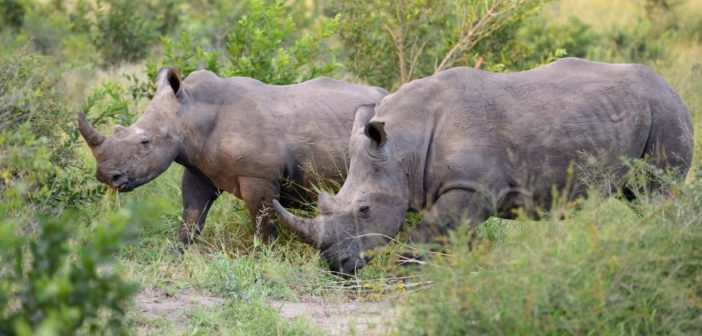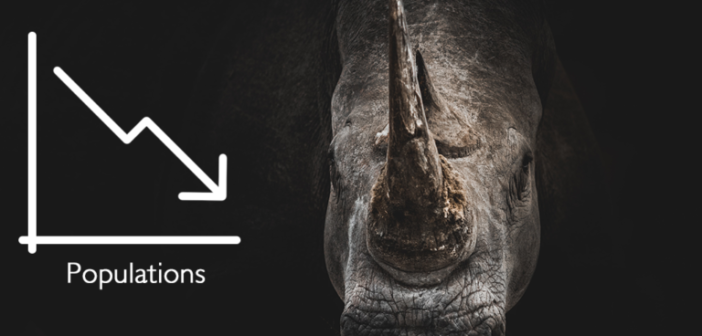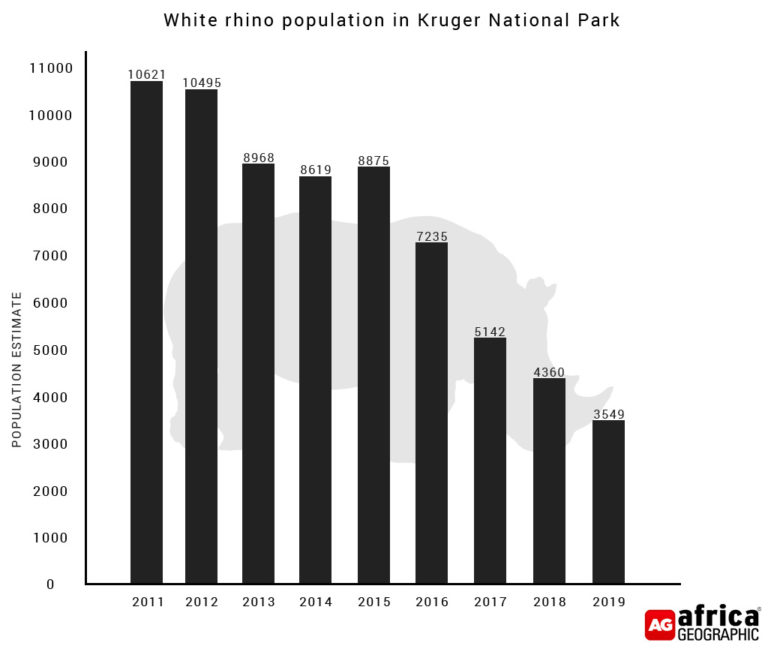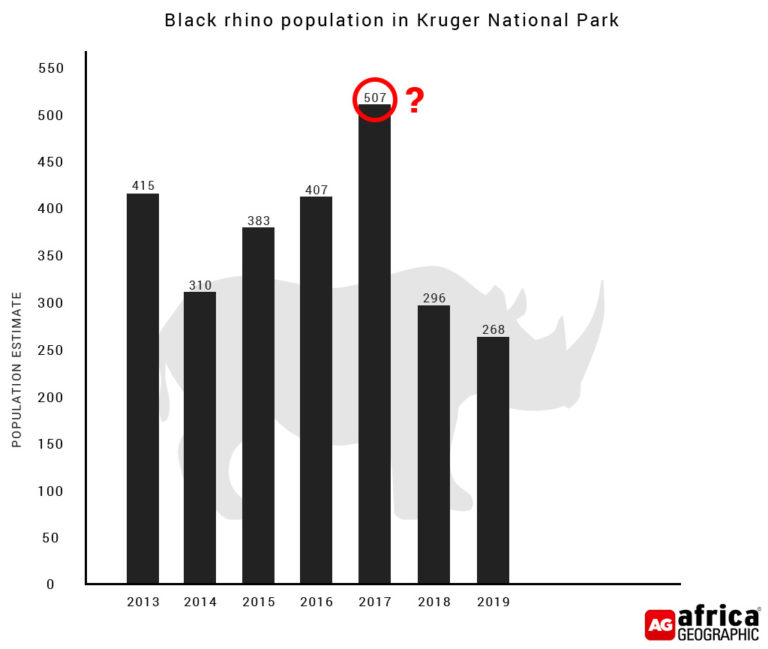By Tony Carnie• 28 January 2021
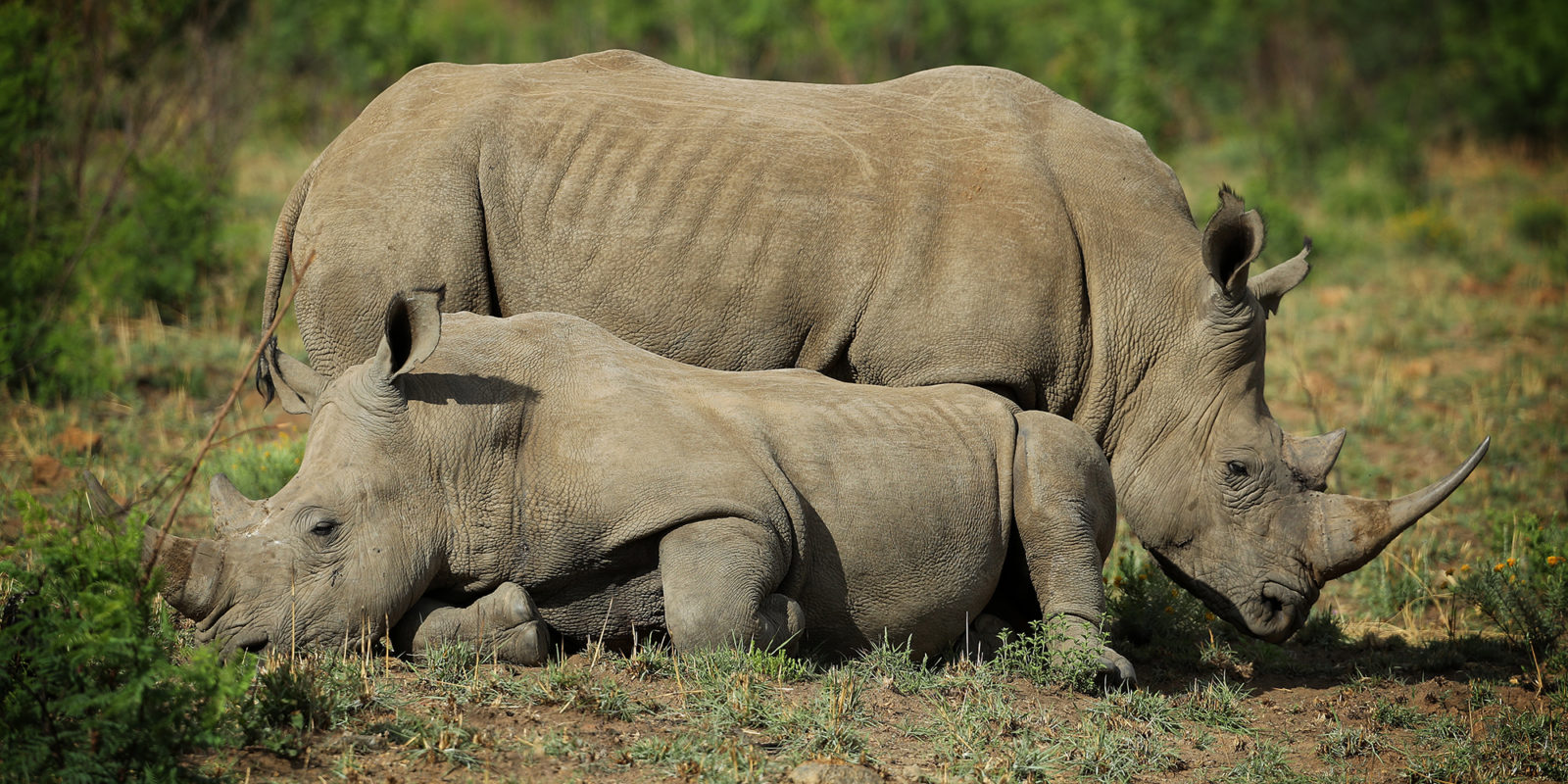
There are an estimated 3,549 white rhinos and about 268 black rhinos left in the Kruger Park after a surge in rhino horn poaching which escalated dramatically from 2008.(Photo: Richard Heathcote / Getty Images)
Shocking official statistics have emerged which show that the world’s single-largest population of rhinos — those living in the flagship Kruger National Park — has been slashed by between 66% and 70% over the past decade, mainly due to the unrelenting wave of butchery by international horn-poaching syndicates.
Over the past two years, Minister of Environment, Forestry and Fisheries Barbara Creecy and her department officials have sought to convey upbeat messages about recent significant declines in the rate of rhino poaching in Kruger and other rhino sanctuaries nationwide — but the latest population statistics strongly suggest that this reported reduction in poaching rates largely reflects that there are now vastly fewer rhinos to poach, especially in Kruger.
Creecy and her department, expected to release a statement on the 2020 national rhino poaching statistics later today, issued a short statement on Thursday night (see footnote) which did not dispute the accuracy of the statistics, which came to light on a single page buried in the SA National Parks latest annual report.
In recent statements, Creecy has suggested that the fight against rhino poaching has turned a corner. Last July, for example, she announced that rhino poaching had decreased by almost 53% in the first six months of 2020, with 166 animals killed for their horns nationwide in that period.
“After a decade of implementing various strategies, and campaigning against ever increasing rhino poaching by local poachers recruited and managed by crime syndicates, efforts are paying off… We have been able to arrest the escalation of rhino losses.”
In 2019, the government announced a 25% drop in the annual poaching rate.
But while overall poaching rates have indeed declined markedly from the peak reached in 2013-2016 (when more than 1,000 were killed each year), rhino experts have cautioned that the lower poaching rates over the past few years are still a matter of significant concern, because there are now fewer animals to sustain natural breeding increases.
In the late 1890s, the southern white rhino almost became globally extinct as a species, but a tiny remnant population of fewer than 100 of these animals in Umfolozi Game Reserve in KwaZulu-Natal was saved by the former Natal Parks Board and gradually multiplied to restock other parks in South Africa and elsewhere on the continent.
Many were sent to the Kruger National Park, which had had a population of just 350 white rhino in the early 1960s. The rapid growth of this population was a major success story for the flagship reserve of the SA National Parks Board — and by 2010, census figures suggested that there were somewhere between 8,700 and 12,200 white rhino the park (a median figure of about 10,450).
Now it has come to light that there are an estimated 3,549 white rhinos and about 268 black rhinos left in Kruger after an unprecedented surge in rhino horn poaching which escalated dramatically from 2008.
(Obtaining precise statistics of wild animal populations is often hampered by the vast area Kruger covers — roughly two million hectares — and not all animals are visible during aerial or ground-based population census operations)
Rhino experts also note that reported rhino poaching numbers tend to underestimate the actual number of deaths because of the difficulty of finding carcasses in dense bush over such a large area with a limited number of field staff.
Over the past decade, the annual stream of rhino poaching statistics has shocked large sectors of the public — but the cumulative total of surviving rhinos in Kruger has received less attention or scrutiny in media statements from Minister Creecy and her predecessors Nomvula Mokonyane and the late Edna Molewa, and official Kruger population figures have not been disclosed officially since the 2017 census.
The latest figures in the SA National Parks annual report now reveal the alarming extent of the cumulative losses at Kruger — somewhere between 66% and 70% over a single decade in one of the world’s best-known game sanctuaries.
Dr Richard Emslie, scientific officer of the IUCN Species Survival Commission and African Rhino Specialist Group, noted yesterday that while absolute poaching rates in Kruger and nationwide had declined significantly, the poaching rates as a percentage of remaining animals was a more significant factor.
Whereas the Kruger white rhino natural growth rate had in the past reached levels as high as 8%-9% annually, the current reported poaching rate of 7.5% of the rhino population per annum in Kruger meant that it would be more difficult for the population to recover.
Emslie noted that these cumulative deaths could not be attributed to poaching alone, as the growth rate had been affected by a severe drought about five years ago and this would have depressed the number of babies born. SANParks had also shifted an undisclosed number of rhinos to other reserves elsewhere in the country (and many others had been relocated internally to more secure “intensive protection zones’ within the park.
Emslie drew an analogy between rhino anti-poaching strategies and a soccer game.
“To win, you have to score more goals than the opposition. So, if you can ensure that more animals are born compared to the number dying, that is how you win.”
While the cumulative number of rhino deaths remained a significant concern, Emslie said the reduced number of rhino in the park also created conditions for a fast recovery.
When animal populations approached the natural carrying capacity of a park, the growth rate was not as high. So there was now potential for a rapid recovery — but only if the poaching rate as a percentage of the surviving population could be brought down further.
“There are many brave and dedicated people we can thank for risking their lives in order to have achieved the significant reduction in absolute poaching over recent years. If Kruger can manage to reduce the percentage of the population being poached then hopefully one could see a start of numbers increasing again.”
Dr Salomon Joubert, the former Kruger park warden who retired in 1994, said yesterday he had been warning since 2014 that the park’s rhino population had reached a tipping point because of the poaching crisis — but his requests for annual census figures had been fobbed off by the department.
Joubert said he believed that many park rangers had gone “beyond the call of duty” to safeguard the rhino population, but he remained concerned that not enough had been done to investigate the involvement of some staff, including several senior rangers, in international poaching syndicates.
He also suggested that SANParks and the department had previously sought to reassure the public that the rhino population decline was not as serious as the latest statistics had revealed.
“I would not be surprised if the current estimate of 3,500 white rhinos has dropped even further since 2019,” he suggested.
In response to queries from Daily Maverick, Creecy’s department said last night that the number of rhino cows killed by poachers had a knock-on effect on overall population levels as this often led to the death of dependent calves and the future loss of calves that a rhino cow would have produced.
“This effect equates to an additional five rhinos lost to the population per loss of one cow, now and in future.”
Poaching also led to social disruption of predominantly black rhino families as cows began to conceive less often.
The recent discovery of bovine tuberculosis in Kruger’s rhino population had effectively halted the translocation of more rhino out of the park to other safer areas.
Drought had also caused other lingering effects, said the department, noting that during the 2015/2016 drought, white rhinos died naturally at twice the normal rate.
Cows did not conceive and Kruger recorded half the birth rate a year after the drought. Two years after the drought, however, Kruger recorded high recruitment rates because many cows simultaneously gave birth in that year.
“Most of those cows are now suckling calves and therefore not as many cows gave birth in 2020 compared to 2019. The gestation period for a rhino cow is 16 months and hence a rhino cow will only calf every 2.5 – 3 years.”
“These combined impacts of variables and often at times low number of births could not offset the poaching rates combined with natural death rates. For instance, for four years prior to 2020, poaching rates were at a minimum 7.5% of the white rhino population, although poaching rates slightly declined to a minimum 6.5% during 2020.
Commenting on the overall declines in Kruger, the department said: “Rhino poaching is a national priority crime and is being addressed through the multidisciplinary Integrated Strategic Management of Rhinoceros approach.
“A more recent addition to the effort to combat rhino poaching and related crimes is the implementation of the principles set out in the draft National Integrated Strategy to Combat Wildlife Trafficking (NISCWT).
“Besides the introduction of species-aspecific management plans for rhino, a Rhino Conservation Lab was held in 2016 to find new ways to secure and manage the country’s rhino population alongside efforts to curb rhino poaching. The High-Level Panel probing, amongst others, rhino and elephant management, is set to deliver its report to the Minister in the foreseeable future.”
Work was also being done in collaboration with private rhino owners to ensure the future of rhino in South Africa.
“During 2020, seven Integrated Wildlife Zones were introduced across South Africa to protect the country’s rhino. These are similar to the Integrated Protection Zones previously utilised within national parks and provincial reserves, and sees an expansion of the effort to protect the world’s largest black and white rhino populations.
“By introducing a zoning approach, the necessary resources are being redirected to areas most in need of support. It also strengthens cooperation between the state and private role-players and is aligned to the objectives of South Africa’s National Integrated Strategy to Combat Wildlife Trafficking. The concept is based on multi-party cooperation, but will ensure the use of appropriate technologies to ensure surveillance, early warning and detection — all in an effort to become more proactive.
“An additional step is being taken by SANParks, nature reserves and private rhino owners who are dehorning rhino in an effort to deter poachers and protect the iconic animals from being killed for their horn.
“The Department is also in the process of establishing the Environmental Enforcement Fusion Centre, which is aimed at coordinating and improving the reactive and proactive response to rhino poaching and other wildlife crime. It has begun to consolidate rhino protection efforts across the country, standardising and boosting tactical level anti-poaching and introducing integrated information-led enforcement.
“This work further strengthens the essential collaboration with the South African Police Service, the Directorate for Priority Crime Investigation (Hawks), the Department of Justice, and other sectors of the security forces to gather, analyse and share intelligence on wildlife trafficking so that the international syndicate-related crimes can be effectively dealt with.” DM/OBP



